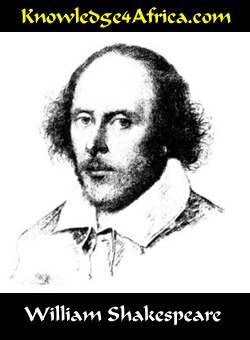|
READ THIS
The poet contemplates the concept of true love where there are no impediments and no changes.
Although love can be seen, its real value can never be measured. Neither is it the plaything of Time,
something that shrinks with the onset of old age.
Indeed, the brightness of youth may disappear as old age advances, but love will continue even till death.
 A LITTLE ANALYSIS
A LITTLE ANALYSIS
The poet speaks of true love in the image of a union of true minds.
The classical form of marriage was something that was indissoluble, could never be broken or set aside.
Indeed, even before the marriage was allowed to happen, the couple and their community were required
to testify that they were aware of no impediments which would be in the way of the marriage. If such
impediments existed, the marriage could not be sanctioned.
So it is with true love: no impediments can exist to get in its way. Once the marriage has happened, it
is permanent. True love is not something that changes even in the face of change.
In Quatrain 2, the poet compares love to something that is permanent and unchanging, a lighthouse which
can be lashed by storms and heavy seas but it does not move or crumble.
It is also like the stars at night which are used to navigate ships across the oceans. Just as a star can
never be measured in terms of value, so is it for true love.
In Quatrain 3, the poet points out that Love is also not a clown -- the "fool" -- of Time.
Old Man Time -- the "Grim Reaper" -- is commonly depicted as using his sickle to harvest life,
reaping all the beauty of youth like "rosy lips and cheeks".
Time, the poet argues, can never harvest true love which remains constant even to the point of death --
"edge of doom".
In the Rhyming Couplet, the poet concludes that he is so certain about what he has argued that he is
prepared to stake on it even his reputation as a poet.
If he is wrong, he says, then he has never written any poetry and no-one in the whole world has ever been
in love.
Since, however, we know that he is indeed a famous poet and we know people have fallen in love, it can
be concluded therefore that his argument is quite correct.
The poem is therefore a controlled exposition of love but through it one is aware of a profound sense of
awe and admiration of the concept of true love.
Have you looked at the questions
in the right column?
|
TEST YOURSELF!
Read the left column and then answer
the following questions:
Let me not to the marriage of true minds
Admit impediments. Love is not love
Which alters when it alteration finds,
Or bends with the remover to remove.
- The poet speaks about a "marriage of true minds". Is he actually referring to marriage at all or
does he have something else in mind? (4)

[Need help?]
Is the poet speaking about marriage? Or is he using the term "marriage" as a metaphor for
something else? Or both?
Marriage, of course, means a union and in this sense the poet probably does mean the union of true
minds. If two people, therefore, are mentally united, then nothing will come between their friendship,
whether it be a marital friendship or a "soul friendship".
The poet could therefore be speaking of male/female friendships, female/female friendships or male/male
friendships.
|
- What does the poet mean when he speaks about "impediments" to a
marriage? (4)

[Need help?]
The Church or State has long had "impediments" which prevent a marriage from taking place.
Some of these are pretty obvious whereas others, especially those introduced by Churches, appear rather
strange.
Consanguinity or blood relationship is the most obvious and is usually put forward by both Church and
State. A man cannot marry his sister, mother, grandmother, daughter, niece, aunt, etc.
Affinity or relationship through marriage is mostly a Church impediment. A woman cannot marry her
step-brother, her husband's brother, etc.
Spiritual relationship is purely a Church thing. A man cannot marry a woman whom he has baptised, or
his god-daughter, etc.
Shakespeare is using this concept of impediments in a metaphorical sense: if the love between two
people is absolutely true, then nothing can prevent their mental union.
|
- Would you agree that "love is not love | Which alters when it alteration finds, | Or bends with the
remover to remove"? Justify your answer. (4)

[Need help?]
There are forces out there, says the poet, which aim at destroying the love or affection of two friends. One
such force is the aging process. Another is ill health.
The poet points out that it is not true love when one partner or the other co-operates with those forces and
actually helps them to destroy the love.
Would you agree with this argument?
|
O no! it is an ever-fixéd mark
That looks on tempests and is never shaken;
It is the star to every wandering bark,
Whose worth's unknown, although his height be taken.
- Are the nautical images -- storms, lighthouses, stars -- valid as images of love?
Explain. (6)

[Need help?]
We are looking here at such things as storms, lighthouses, sailing vessels and stars, aren't we?
The lighthouse is so solid that no matter what storms lash at the walls, no matter what waves crash
against it, it will stand immovable.
Love is the indestructible foundation to all relationships because, no matter what the storms, the love will
hold the relationship together.
The Elizabethan Age was also the great age of sailing ships which plied their way over the oceans to the
new worlds beyond. The captains of these vessels mapped their progress by taking readings from the
stars at night.
As long as the stars could be seen, the ship could be safely guided to and from its destination. The poet
says that love is the star for relationships: as long as there is love, the relationship will not get lost in the
sea of daily strife.
Are all these successful images of love?
|
Love's not Time's fool, though rosy lips and cheeks
Within his bending sickle's compass come.
- When the poet speaks of "Time's fool", is he saying that love is not an idiot?
Explain. (4)

[Need help?]
Kings used to have their court jesters who were known as "fools" whose function it was to make
the monarch laugh.
The fool also had a vital role to play in the court because, in his mirth, only the fool was allowed to tell the
total truth, which meant that he could inform of possible stupidity being committed by the monarch or his
advisors.
"Love is not the fool of Time", says the poet.
We have here the personification of time, Old Man Time or the Grim Reaper, who goes around with his
sickle collecting the dead into his harvest. Like a king, Time has his "fool" or court jester
accompanying him.
|
- Why should "rosy lips and cheeks" within Time's "bending sickle's compass
come"? (4)

[Need help?]
Rosy lips and cheeks are synonymous with youth, aren't they.
People fall in love in the full exuberance of puppyhood but will this love last when age starts creeping in
and taking away the fleshiness of puppyhood, giving wrinkled skin, sagging breasts, etc?
|
Love alters not with his brief hours and weeks,
But bears it out even to the edge of doom.
- Explain the image that the poet is using here. (4)

[Need help?]
Life is sometimes compared to the seasons of the year: e.g. one is in the springtime of one's life, or in
the autumn of one's life.
Life may also be compared to the passing of the day: e.g. the sun has set on a productive life.
In this sonnet, Shakespeare compares life to both hours of the day and to weeks of the year.
|
- Comment on the image "the edge of doom". (4)

[Need help?]
"Doom" would be synonymous with death, wouldn't it?
The poet is reflecting on the ancient Greek concept of death whereby one had to cross the sacred river
to enter the Land of the Dead.
Death was therefore a frightening experience, the passing into the Doom beyond.
|
GENERAL QUESTION
In our modern age of quick marriages and sometimes quicker divorces, why would you think this sonnet
is an important one to contemplate? (10)

[Need help?]
This is very much a debating question and so there is no absolute answer.
If you are arguing within the context of this poem, you need to understand the poet's standpoint and to
explain it within his images.
Then you need to examine the forces at play within modern marriages. Only then can you reach a
justifiable conclusion.
|
|



